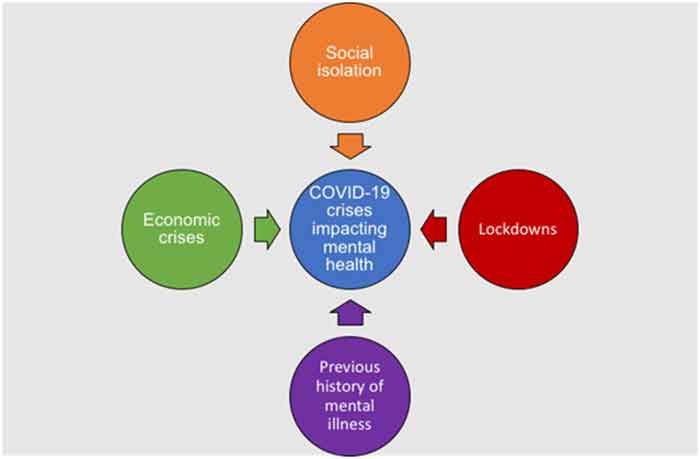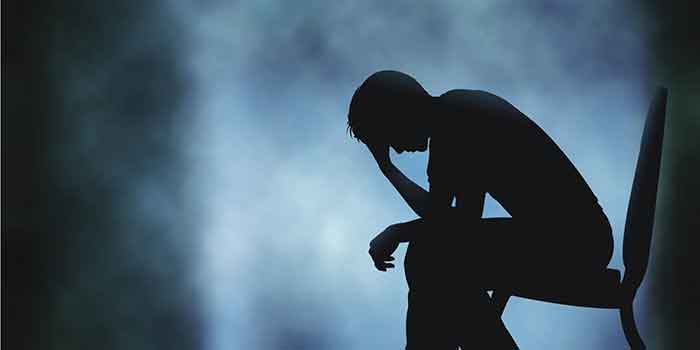Co-Written by Disha Malik, Shubhangi Kandwal & Upasna Gaba
In December 2019, several cases of pneumonia were reported with unknown aetiology in Wuhan, Hubei Province, China. Since then the disease has spread in other parts of China and the world causing a global pandemic. (Hagert & Williams,2020). The sudden outbreak of COVID-19 led to an obligation to quarantine and increased societal concerns. Such concerns were due to exposure of the people to the periodic media releases describing unprecedented circumstances demanding novel preventive approaches as well as the evidence of possibly fatal consequences. From the evidence available it is suggested that such distress may impact the stress and anxiety levels (Figure 1). It will also result in a change in the health-seeking behavior of the public (Colizzi et al., 2020).

Figure 1. Depicts the factors such as economic crises, lockdowns, social isolation or previous history of mental illness which can contribute to developing mental illness in the present COVID-19 pandemic situation.
The general public, particularly the vulnerable groups who are at high-risk are recommended to stay indoors. They are advised to quarantine themselves at home as it is perceived to be the most reliable method to eliminate the possibilities of infection. However, staying indoors impacted the mental health of various vulnerable groups.
Impact of COVID-19 on children
Due to the closure of schools, playgrounds and parks during COVID-19 and the lockdown has had a major impact on children and adolescents psychologically (Wang et al., 2020; Ghosh et al., 2020). Children are suffering from boredom, anxiety related to education, irritability, developmental issues and fear of infection which can initiate distress and confusion and also trigger adverse psychological consequences in children (Wang et al., 2020). Children possibly can be vulnerable to misinformation and disruption of the daily routine can cause psychological symptoms like tantrums, aggression, clingy behaviour, bedwetting in children and substance use in adolescents (Das, 2020). COVID-19 tends to develop a phobia in children and also the learning through media can lead to PTSD- Post-traumatic stress disorder (Muris & Field, 2010). Children with single parents can tend to suffer more in case of the infection to parents and can have adjustment difficulties. This parent-child separation can have a prolonged psychological impact on the child at the time of fear during this pandemic (Dubey, Jana Dubey, et al., 2020). To help children during this time proper parenting is necessary, a sleep cycle should be maintained, some amount of physical exercise daily and parents should educate children about proper hygiene practices. Online classes and study material provided by educational institutions should be clear and detailed and not overwhelming for children (Wang et al., 2020).
Impact of COVID-19 on elderly people/Old age
Older adults have medical comorbidities which make them vulnerable to COVID-19 and this then can cause fear in elderly people (Das, 2020). Older people have decreased immunity due to ageing and along with other comorbidities, it puts them at risk during the time of this pandemic (Gavazzi & Krause, 2002). Psychological symptoms that have been observed in the elderly are irritability, anxiety, stress, anger, insomnia, depression and worsening of medical conditions (Das, 2020; Lee et al., 2005; Li et al., 2020). Increased anxiety, agitation and social withdrawal are observed in older adults with cognitive decline (Lloyd-Sherlock et al., 2020). Also, they had to face problems in the already scheduled check-up sessions and follow up sessions and also due to lockdown and ban on travelling caused problems in accessing medicine (Dubey, Biswas, et al., 2020). Interventions like daily physical exercise inside the house, telephonic sessions with their physicians and video calls for guidance and online medicine delivery system can help them through this era of the pandemic (Jiménez-Pavón et al., 2020; S. Liu et al., 2020; Qiu et al., 2020).
Impact of COVID-19 on jobless, immigrant refugees, daily wagers, slum dwellers
Immigrant workers, slum dwellers and daily wage workers collectively the marginalised community are the ones that are suffering the most (Liem et al., 2020). Due to the lockdown, they have lost their jobs, they are already vulnerable to psychiatric disorders like depression due to government policies for them and along with this their tendency for poor mental health increase (Truman et al., 2009). The slum dwellers and daily wage workers, they live in places where the chances of infection are more. Some of the government restrictions like on safety, water and other things they are mostly impacting these people leaving them neglected. Due to the lockdown, these people have lost their jobs and due to lack of income, lack of support from anyone and uncertainties they are suffering from depression, financial stress, anxiety, insomnia and stigma of discrimination and even some of them are committing suicides (Qiu et al., 2020). This situation can be intervened by proper accommodation, health and hygiene education, a supply of food and water from government and NGOs, basic human rights, affordable health care and referrals to psychologists if required (Das, 2020; Kirby, 2020).
Impact of COVID-19 on Health care workers
Moral injuries are psychological distress that results from actions, or lack of them which violates someone’s moral or ethical code. They can lead to extreme feelings of shame, guilt, and disgust. Further, they can contribute to depression, anxiety, Post-traumatic stress disorder (PTSD) and even thoughts of suicide (Greenberg et al., 2020). The health care workers can be negatively impacted by exposure of COVID-19, the lethality of the virus, quarantine, and perception of the danger of illness of friends and family. These have already been observed in the time of SARS -CoV epidemic (X. Liu et al., 2012; Wu et al., 2009). Isolation, lack of success in giving proper treatment to patients, and fear of infection have been observed in medical professionals majorly in the densely affected countries (Lai et al., 2020). Developing countries tend to lack resources like PPE kits, hand hygiene tools etc, which is leading to stress, irritation and acute anxiety symptoms in the health care professionals(HCP’s) (Biswas & Chatterjee, 2014). Many of the HCP’s have shown to be suffering from all forms of depression from mild to severe and also some of them are suffering from insomnia (Lai et al., 2020).
References:
Colizzi, Marco & Bortoletto, Riccardo & Silvestri, Marta & Mondini, Federica & Puttini, Elena & Cainelli, Chiara & Gaudino, Rossella & Ruggeri, Mirella & Zoccante, Leonardo. (2020). Medically unexplained symptoms in the times of Covid-19 pandemic: a case-report. Brain, Behavior, & Immunity – Health. 100073. 10.1016/j.bbih.2020.100073.
Wu A, Peng Y, Huang B et al (2020) Genome composition and divergence of the novel coronavirus (2019-nCoV) originating in China. Cell Host Microbe. 10.1016/j.chom.2020.02.001
SIGN UP FOR COUNTERCURRENTS DAILY NEWSLETTER













































